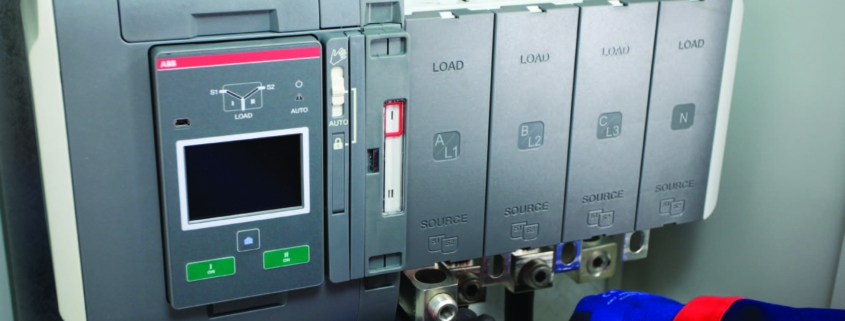3 Cs of designing reliable panel power systems
Panel builders and end users interested in more reliable, more functional panel power system should consider the 3 Cs: Complexity, Clutter, and Cost.
The constant element in every control panel is an electrical power system. Panel builders and buyers have nearly unlimited options when it comes to designing their power systems. That flexibility can make choosing the best components difficult. One way to simplify your selection is to consider the 3 Cs of power system design: Complexity, Clutter, and Cost.
Complexity
The overall complexity of a power system is largely driven by the application. A panel controlling a pair of paralleling generators will be considerably more complex than one controlling a basic pump. But regardless of overall system complexity, you have options for simplifying the power system.
Devices that combine multiple functions are a key to reducing complexity. Power-quality metering, for example, can be accomplished in a single device with a menu that allows you to scroll through amps, volts, watts, power factor, etc. That’s a far simpler approach than separate meters for each value. And multiple meters make it harder for operators and maintenance people to find the information they need, increasing the likelihood of mistakes.
A single meter also means greatly simplified wiring, with only six wires needed to make the current transformer connections. Multiple meters require wiring from the transformer to each meter. More wires mean more connections, with a direct decrease in reliability. A power system that requires N components is clearly more reliable than a system where N is greater than 2. As N increases, reliability further decreases. The wiring reduction created by selecting multifunction devices is one of the keys to not only reduced complexity but also increased reliability.
Clutter
Clutter is related to complexity but represents some different issues to consider. Users appreciate the appearance and the simplicity of an uncluttered panel face. Multifunction devices help clear the clutter. As one example, you can select breakers that do the job of meters and relays in addition to their primary job of interrupting current during faults.
Relying on fewer components creates a less-cluttered design, with a cleaner panel front, less wiring to troubleshoot, and reduced maintenance. It also means less annunciation on the panel, making it easier for operators and maintenance people to easily find the desired function/control and quickly identify – and resolve – any issues.
Another way power-system design can be greatly streamlined is by selecting devices with the required communication capabilities built in. Relying on devices with native Modbus TCP protocols will result in a far less-cluttered panel than relying on serial Modbus RTU, with its multiple serial converters and concerns about the number of devices on each converter.
A good example of how clutter and complexity can create a crisis is a data center that opted for a control panel with a large number of controls and indicators on the front. When they experienced a cascading error, the maintenance team couldn’t figure out how to interface with the system. The connected generator shut down and the team was unable to do anything but wait helplessly. After 20 minutes, the backup batteries were exhausted and the entire system went down, resulting in many angry customers. That problem was self-inflicted; the complexity of the panel made it impossible for the maintenance team to troubleshoot.
Cost
Simpler, less cluttered panels sometimes come at a somewhat higher initial component cost. But the higher initial cost is usually recouped through lower maintenance expense over the life of the panel because simpler panels require less maintenance. It’s also more likely that any capable maintenance team member can handle issues that come up without special training.
For the panel builder, the sometimes higher cost of multifunction components is typically offset by the reduced installation, assembly, and programming time. For example, with an open-style transfer switch, you have to mount the switch, mount the controls, and then wire those devices. A newer transfer switch is actually competitive pricing with the more traditional open-style and only requires just three mounting bolts and a power connection.
The reliability gains of these simpler, less-cluttered designs can reduce the likelihood of warranty claims and related costs. After the warranty period expires, panel builders typically direct panel owners to the component manufacturer for support. But well-respected panel shops look beyond the warranty period, providing panels that are likely to provide end users with trouble-free service for years to come. End users appreciate knowing that they are likely to have little to no maintenance on their panels.
Panel design is a perfect example of the need to look beyond component cost and consider total cost of ownership of the panel.
The 3 C payoff
Long-time car mechanics wistfully recall the days when they could replace a front wheel bearing, costing them less than $20. Today they have to buy a complete bearing and hub unit, at over five times the cost. But considering the total installation cost, that unit is a bargain. It quickly bolts on, with no adjustment or lubrication needed … ever. Sensors for traction control and braking systems are built in and connected via plugs. Installation is much faster, and bearing-related issues and maintenance are virtually eliminated.
Panel builders who are comfortable with proven, single-function components may not see enough advantages to warrant upgrading to costlier multi-function devices. But these more-advanced power-control system components are only marginally, if at all, more expensive than the alternative individual components. Any slightly higher cost is quickly recovered with cost reductions related to installation and wiring, maintenance, and the likelihood of reduced warranty claims. And as an added benefit, panel builders can tout the increased reliability, as well as the reduced lifecycle cost and increased ease of operations and maintenance of their less complex, less cluttered panel designs.
—
Harry Handlin
Data Center Solutions Architect




